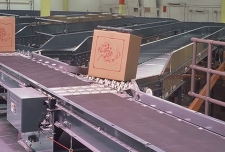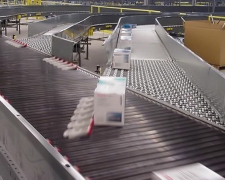Transportation Conveyors
Roller Conveyors
Roller conveyors generally consist of a frame that supports carrier rollers. Carrier rollers are generally 1-2 inches in diameter and come in a variety of lengths, finishes and bearing types. Roller conveyors have two main purposes: transportation of product between different areas of the facility and accumulation of product in picking and packaging areas of a warehouse. Roller conveyors are powered in several different ways including padded chain, v-belt, round-belt and line-shaft drive media.
Benefits of using roller conveyors can include:
- Quiet operation, low energy consumption
- Reduced maintenance cost, less noise
- System easily reconfigurable
- Economical, easy installation
Belt Conveyors
Belt conveyors generally consist of a frame that supports a moving belt as the carrying media. Belt conveyors have three general applications: inclining and declining product from different elevations; as a loading conveyor in order selection areas; and as an empty carton conveyor.
Benefits of using belt conveyors can include:
- Smooth transition for small products
- Low initial cost, reduced spare parts cost, ease of installation and maintenance
- Lowers power requirement, conserves energy
- Fast installation of inclines/declines
Accumulation Conveyors
Whether you’re accumulating trays or difficult product shapes or panels, we can help you find the best solution to fit your unique distribution needs. We specialize in gentle handling, low pressure and non- contact accumulation conveyor systems.
Accumulation conveyors typically are roller conveyors with the ability to "bunch up" or "close the air gaps" between the products that they are moving throughout the warehouse and packaging areas. Accumulation generally takes place prior to approaching the metering or merging conveyors. By closing the gaps, product can be efficiently released to the downstream conveyors. Accumulation generally is accomplished by turning drive power on and off under short zones of roller conveyors as a product approaches the zone. Typically, mechanical sensors of photo-eyes detect the presence of product.
With gentle handling, low pressure accumulation, and non-contact accumulation, these automated conveyor systems ensure product accumulation is done in and effective and efficient manner.
Merge & Induction Conveyors
Merge Conveyors
Merge conveyors typically are live roller conveyors arranged to combine several in-feed conveyors into fewer downstream conveyors. Most distribution center applications include a main merge that combines the product from several order selection areas into a single conveyor for transportation to the main sorter.
This merging process is needed to combine product from upstream pick modules with multiple lines, into a single stream of product on a single conveyor. The merging process then sends a single stream of products downstream for further processing often into a sorter, in-line scale, or scanner.
Metering Conveyors
The primary purpose of metering conveyors is to control the release of product to the downstream conveyor. Metering conveyors are used in applications where product counting and scanning may be required and generally consist of two adjacent belt conveyors running at slightly different speeds. This speed differential creates a gap between product that allows for counting, scanning and other operations.
Induction Conveyors
Induction conveyors are very similar to metering conveyors. Their primary purpose is to create sufficient gap and speed for scanning and introduction to the sortation conveyor. More elaborate systems that require products to be delivered to different locations throughout the warehouse; will need some sort of sortation solution. Choosing the right sorter is a factor of many things: the physical attributes of the conveyed items, throughput rates, and space limitations to name a few which are all things that DirectConneX will uncover during our engineering study at your facility.
Sortation Conveyors
Deflector Arms
Deflector arms are one of the simplest and least expensive devices available. They consist of either manual or mechanized arms that deflect the product to the desired destination. Deflectors act as barriers to the product flow. Manual arms are intended only to divert "trains" of products, while mechanized arms are capable of selectively diverting product. Since they do not come into contact with the conveyor, they can be used with almost any flat surface conveyor.
Pusher Sorters
Pusher sorters consist of a moving ram with a paddle that sweeps across the conveyor to push the product off the opposite side. The pusher face then retracts until it is required to divert more product. These devices are usually hydraulically or pneumatically operated, but also include motor driven devices. Pushers offer flexibility of manual or automatic control and are inexpensive to operate. The use of pushers is limited to low throughput applications.
 Pop-Up Wheel Sorters
Pop-Up Wheel Sorters
Pop-up wheel sorters handle a wide variety of products with flat bottoms. One of the most frequently used sortation devices, these sorters consist of one or more rows of powered wheels that pop up above the surface of the conveyor. They contact the bottom of the product, lift it above the conveying surface, and guide it off the conveyor at an angle. The wheels are lowered when there is no need to divert product. The best uses for pop-up wheel sorters are medium-throughput applications.
Swivel Wheel Sorters
Swivel wheel sorters have much in common with pop-up wheel sorters. The main difference is that the wheels are always in the up position. When product needs to be diverted, the rollers swivel in the direction of the divert, contact the bottom of the product, lift it about the conveying surface and guide it off the conveyor at an angle. The wheels are oriented in the direction of flow when there is no need to divert product. Swivel wheel sorters also are best used in medium-throughput applications.
 Sliding Shoe Sorters
Sliding Shoe Sorters
Providing a great deal of flexibility for sortation at high rates, the sliding shoe sorter uses a series of divert shoes that slide across the horizontal surface to engage the product and guide it off the sorter. These sorters are wide conveyors in which the shoes move from side to side as the product flows in order to divert the product to either side. Slide shoe sorters are capable of handling a wide variety of products with a smooth, yet very positive, divert. These sorters are best used in medium to high throughput applications.
Tilt Tray Sorters
Both tilt tray sorters and cross belt sorters are endless loops or "train" style conveyors. Both employ multiple induction and discharge points. The physical layout of the induction and discharge points can dramatically affect overall throughput. A tilt tray sorter product is carried on hinged trays that can tilt in either direction at discharge point. These trays, or slats, carry items on a flat surface. Slats tilt to discharge product. Various products and shapes can be handles. These sorters are typically used in high-speed systems. Both tilt tray and cross belt sorters can accommodate modest changes in elevation.
Cross Belt Sorters
Similar to tilt tray sorters, the cross belt sorter carries product on short belt segments mounted 90 degrees to the conveyor's line to travel. This short belt, or cross belt, energizes to divert product at the product at the discharge point. As with the tilt tray sorter, the physical layout of the induction and discharge points can dramatically affect the overall throughput. A large number of induction points can be accommodated. Applications can vary from low to high throughput systems.
NBS® Narrow Belt Sorters
A recent innovation, TGW-ERMANCO Narrow Belt Sorters deliver key advantages over conventional sorters, reducing energy usage, noise, and installation time. The sorters utilize a series of narrow belts, each with its own take-up. The ideal application is within the key middle range of sortation throughput providing efficient and cost-effective performance.
Key Benefits:
- Reduces energy consumption by 70%, noise level by 75%, and installation time by 40% over conventional sorters
- Picks up product “on the fly,” maximizing sort rate
- Conveys product along entire length on belt, delivering quiet operation and increasing accuracy of diverts
- Individual belt take-ups for smooth product flow and long belt life
- Modular divert mechanisms allow quick, easy reconfiguration of system
- Simple design for ease of maintenance

